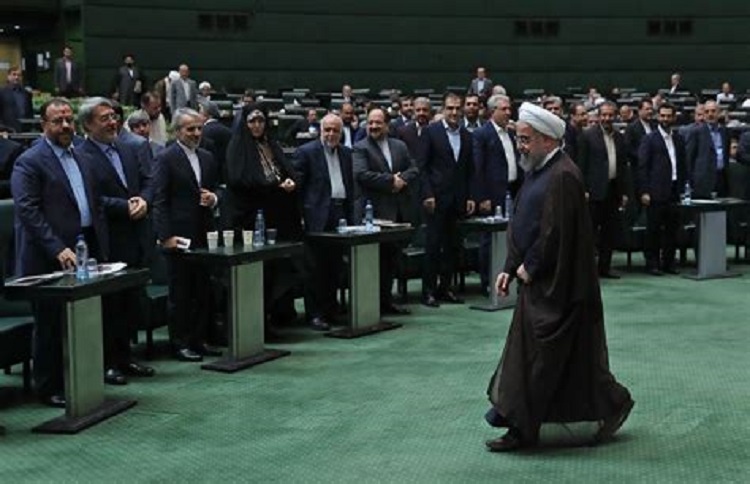
By Pooya Stone
“Sometimes an earthquake causes just one ripple on the ground, or a few cracks and fissures in works of art, bridges, and buildings. After thousands of years of earthquakes, a large crevice appears in the landscape like those in Iceland or the San Andreas Fault in California.
After becoming visible and are printed on a map, those traces and marks both reveal and hide a giant fault at the level of the lower plate that moves slowly but suddenly break off unseen in tectonic abysses. That fault is the underlying cause of all those surface movements,” from the definition of ‘Times of Crisis,’ wrote by Michel Serres.
Ominous Triangle
The evolution of the political and social contradictions of the Iranian people with sovereignty in general as well as the maturity of the crises within the governing system, in particular, indicate the existence of a major contradiction called “Vali-e Faqih.”
The Iranian government is stuck in a triangle of “the supreme leader [Vali-e Faqih], the Guardian Council, and the Revolutionary Guards.” In this respect, this type of ruling system has no option to overcome problems it faces every day. On the other hand, these problems are amassing more and more due to the officials’ lack of real plans to solve them.
The fact is that Iran’s entire governing system is the same triangle and the rest of its organs, such as the administration, parliament, and the Khamenei-controlled judiciary system, are merely involuntary puppets. The triangle is the sole decision-maker over the country’s national properties, environmental resources, public capital, and other costs and revenues.
Start of Sudden Phase Change
The current situation has signs and indicators that attest to the absolute impasse of the “Vali-e Faqih” ruling system in all sectors of sovereignty. The elimination of the commander of the IRGC’s Quds Force Qassem Soleimani as the government’s second man pushed the Iranian government into a new phase.
Subsequently, public developments were accelerated by the shooting down of the Ukrainian passenger airliner and killing all 176 passengers abroad by the IRGC and ironic nonsense for evading the IRGC from consequences of that horrible disaster.
Following two mentioned events, students sparked a new wave of protests that focused on Vali-e Faqih’s functions. Students’ revolt against the ruling system in seven provinces resulted in a new spike in the development of political and social contradictions of Iran and moved domestic crises into a new phase.
On the other hand, 200 of Khamenei’s advocates under the name of “principlists” warned the supreme leader about the November protests in an open letter. They said that the quality of the November protests, reasons and fields, high casualty rate, and not declaring the official figure, are the starting point of a complex crisis that is tied with the government’s fate.
Triangle of “Nothing”
On January 17, Khamenei attended the Friday prayer ceremony after eight years. His supporters expected that the supreme leader rescues the country from the dire conditions with supreme solutions.
However, Khamenei’s remarks gave his audiences no solution, no new recommendation, and no bright anticipation. Khamenei’s desperate sermon has proven that he cannot go further than his ominous triangle for resolving the piling economic, social, political, and international obstacles and crises.
In this context, observers reckoned that Khamenei’s desperation and disillusionment show the Iranian government faces a firm stalemate in different sectors. Particularly, the ayatollahs’ rule cannot improve the livelihoods of the people on the one hand, and it is simultaneously unable to deter more anti-establishment demonstrations that are going to get stronger and wider.
The confluence of Collapse and the People’s Uprisings
Iran’s supreme leader knows better than anyone that if he accepts concessions in any side of the power triangle, his government is compelled to acquiesce to an endless chain of reductions in various areas. The truth is he cannot change any pieces of this chess because any turmoil in the IRGC and the Guardian Council would cause miserable consequences.
The administration and the parliament have no effective role in important decisions like the fate of nuclear projects and the Joint Comprehensive Plan of Action (JCPOA), approval or disapproval of the Financial Action Task Force (FATF) bills, etc. Khamenei as the main decision-maker of the Islamic Republic regime has locked all these issues and the end of these crises to his opinion or the Guardian Council, which he controls.
Evidence displays that the Iranian government has exhausted all its strategic resources and has no potential to tolerate new crises. Simply, the state that constructed his survival on the creation and exporting crises beyond its now suffers from instability inside its borders.
In conclusion, in parallel with the weakening of the Supreme Leader, the Guardian Council as Khamenei’s means for quitting his shareholders in power, and the IRGC as the main part of the oppressive apparatus, the Iranian government faces more crises that endanger its existence. Additionally, the outraged people’s demands are going to be more fundamental, which challenge the continuation of this type of ruling system.


